Anglia Ruskin University - Adult Nursing Insight Placement Homework
VerifiedAdded on 2023/04/20
|28
|7835
|152
Homework Assignment
AI Summary
This assignment is designed to provide mental health nursing students with insights into adult nursing practices. The assignment begins by outlining the patient's journey through the healthcare system, including different admission routes and care settings. It emphasizes the importance of a holistic and individualized approach to patient care, considering both physical and psychological aspects. The assignment then delves into patient assessment and care planning, including the Activities of Living model (ALs) and pain assessment. Students are asked to reflect on how these concepts apply to specific patients, identify patient-focused problems, and consider the psychological impact of pain. The assignment encourages students to use resources like textbooks, the internet, and research articles to complete activities and reflect on their learning experiences in the adult nursing setting.
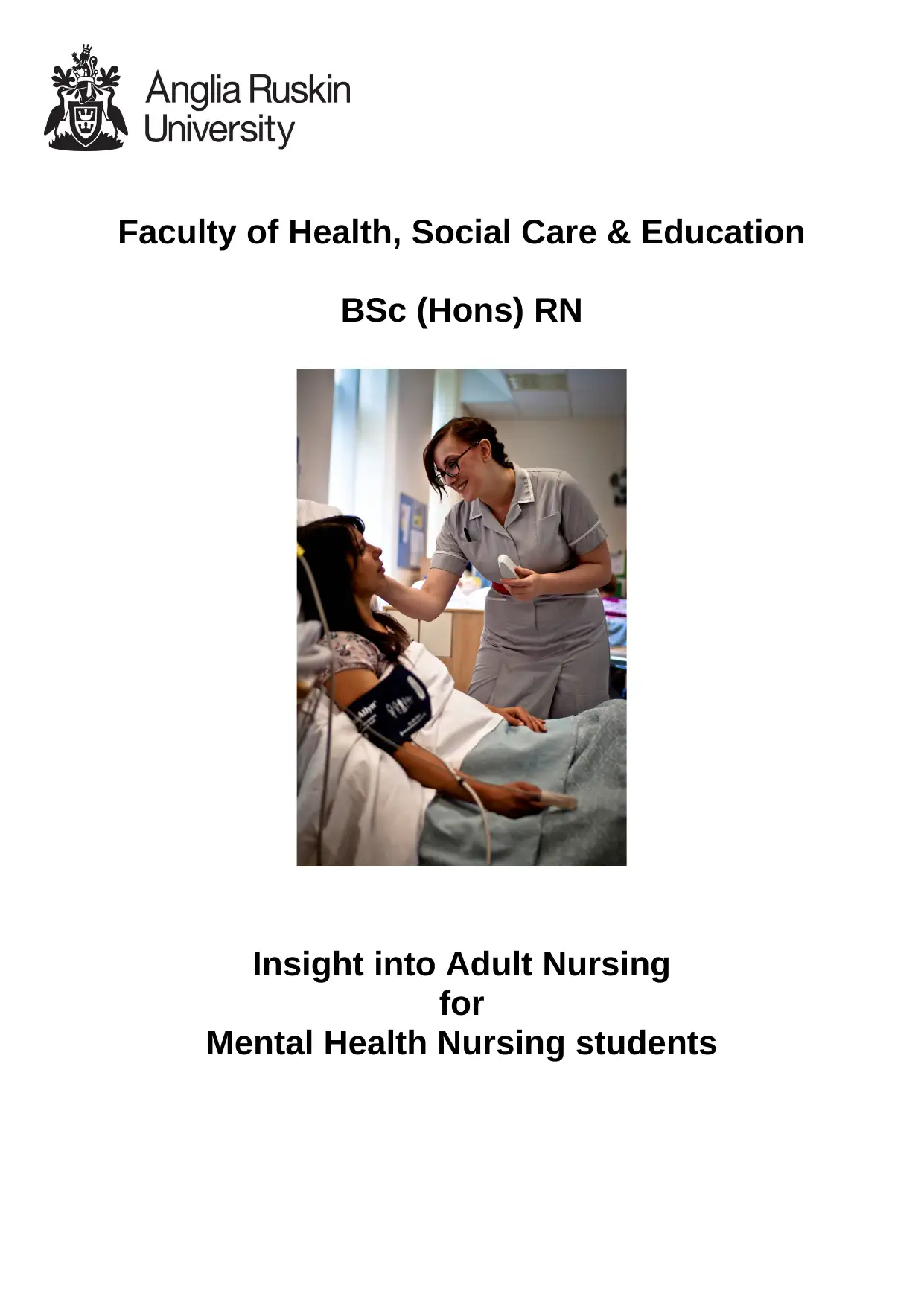
Faculty of Health, Social Care & Education
BSc (Hons) RN
Insight into Adult Nursing
for
Mental Health Nursing students
BSc (Hons) RN
Insight into Adult Nursing
for
Mental Health Nursing students
Paraphrase This Document
Need a fresh take? Get an instant paraphrase of this document with our AI Paraphraser
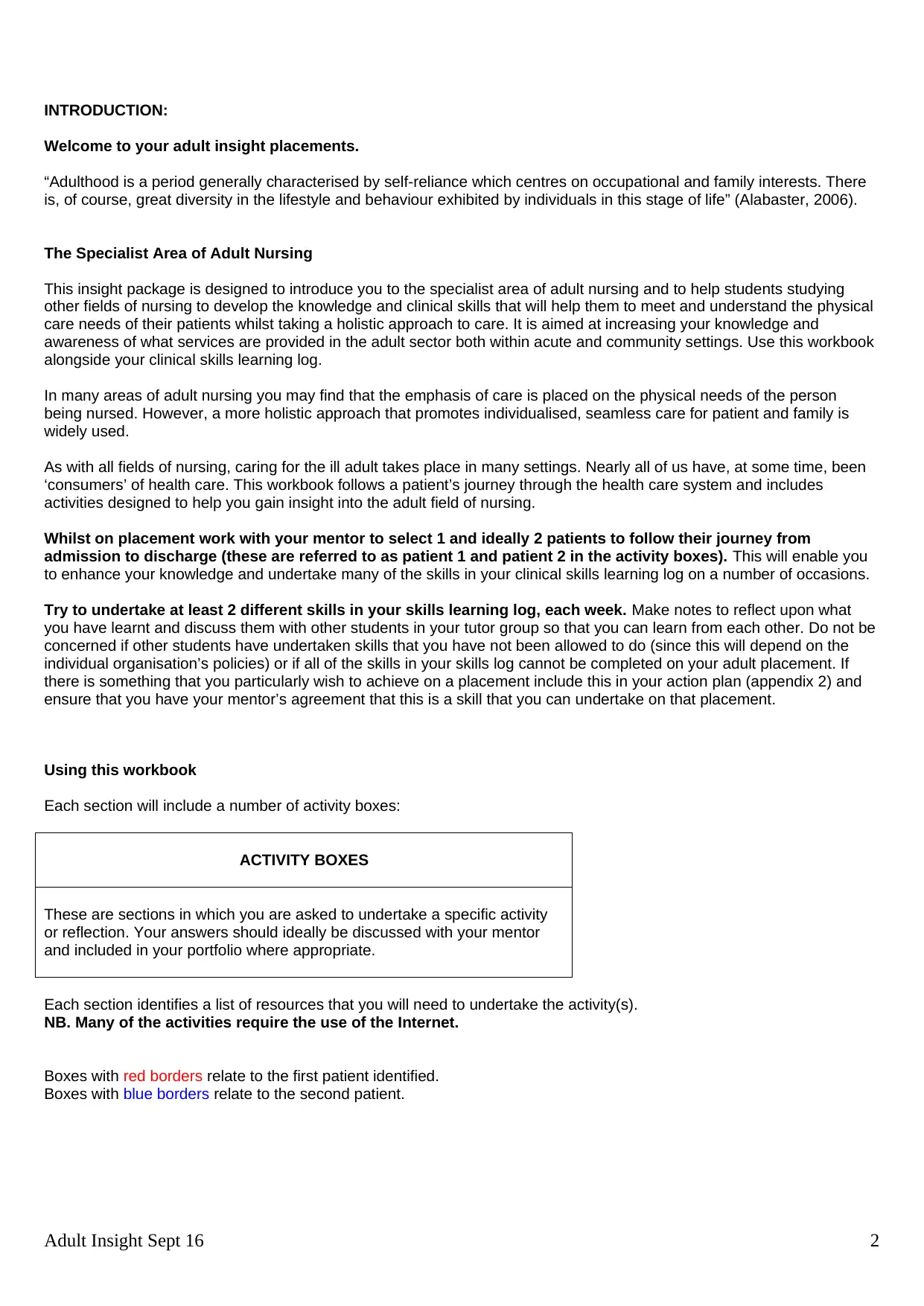
INTRODUCTION:
Welcome to your adult insight placements.
“Adulthood is a period generally characterised by self-reliance which centres on occupational and family interests. There
is, of course, great diversity in the lifestyle and behaviour exhibited by individuals in this stage of life” (Alabaster, 2006).
The Specialist Area of Adult Nursing
This insight package is designed to introduce you to the specialist area of adult nursing and to help students studying
other fields of nursing to develop the knowledge and clinical skills that will help them to meet and understand the physical
care needs of their patients whilst taking a holistic approach to care. It is aimed at increasing your knowledge and
awareness of what services are provided in the adult sector both within acute and community settings. Use this workbook
alongside your clinical skills learning log.
In many areas of adult nursing you may find that the emphasis of care is placed on the physical needs of the person
being nursed. However, a more holistic approach that promotes individualised, seamless care for patient and family is
widely used.
As with all fields of nursing, caring for the ill adult takes place in many settings. Nearly all of us have, at some time, been
‘consumers’ of health care. This workbook follows a patient’s journey through the health care system and includes
activities designed to help you gain insight into the adult field of nursing.
Whilst on placement work with your mentor to select 1 and ideally 2 patients to follow their journey from
admission to discharge (these are referred to as patient 1 and patient 2 in the activity boxes). This will enable you
to enhance your knowledge and undertake many of the skills in your clinical skills learning log on a number of occasions.
Try to undertake at least 2 different skills in your skills learning log, each week. Make notes to reflect upon what
you have learnt and discuss them with other students in your tutor group so that you can learn from each other. Do not be
concerned if other students have undertaken skills that you have not been allowed to do (since this will depend on the
individual organisation’s policies) or if all of the skills in your skills log cannot be completed on your adult placement. If
there is something that you particularly wish to achieve on a placement include this in your action plan (appendix 2) and
ensure that you have your mentor’s agreement that this is a skill that you can undertake on that placement.
Using this workbook
Each section will include a number of activity boxes:
ACTIVITY BOXES
These are sections in which you are asked to undertake a specific activity
or reflection. Your answers should ideally be discussed with your mentor
and included in your portfolio where appropriate.
Each section identifies a list of resources that you will need to undertake the activity(s).
NB. Many of the activities require the use of the Internet.
Boxes with red borders relate to the first patient identified.
Boxes with blue borders relate to the second patient.
Adult Insight Sept 16 2
Welcome to your adult insight placements.
“Adulthood is a period generally characterised by self-reliance which centres on occupational and family interests. There
is, of course, great diversity in the lifestyle and behaviour exhibited by individuals in this stage of life” (Alabaster, 2006).
The Specialist Area of Adult Nursing
This insight package is designed to introduce you to the specialist area of adult nursing and to help students studying
other fields of nursing to develop the knowledge and clinical skills that will help them to meet and understand the physical
care needs of their patients whilst taking a holistic approach to care. It is aimed at increasing your knowledge and
awareness of what services are provided in the adult sector both within acute and community settings. Use this workbook
alongside your clinical skills learning log.
In many areas of adult nursing you may find that the emphasis of care is placed on the physical needs of the person
being nursed. However, a more holistic approach that promotes individualised, seamless care for patient and family is
widely used.
As with all fields of nursing, caring for the ill adult takes place in many settings. Nearly all of us have, at some time, been
‘consumers’ of health care. This workbook follows a patient’s journey through the health care system and includes
activities designed to help you gain insight into the adult field of nursing.
Whilst on placement work with your mentor to select 1 and ideally 2 patients to follow their journey from
admission to discharge (these are referred to as patient 1 and patient 2 in the activity boxes). This will enable you
to enhance your knowledge and undertake many of the skills in your clinical skills learning log on a number of occasions.
Try to undertake at least 2 different skills in your skills learning log, each week. Make notes to reflect upon what
you have learnt and discuss them with other students in your tutor group so that you can learn from each other. Do not be
concerned if other students have undertaken skills that you have not been allowed to do (since this will depend on the
individual organisation’s policies) or if all of the skills in your skills log cannot be completed on your adult placement. If
there is something that you particularly wish to achieve on a placement include this in your action plan (appendix 2) and
ensure that you have your mentor’s agreement that this is a skill that you can undertake on that placement.
Using this workbook
Each section will include a number of activity boxes:
ACTIVITY BOXES
These are sections in which you are asked to undertake a specific activity
or reflection. Your answers should ideally be discussed with your mentor
and included in your portfolio where appropriate.
Each section identifies a list of resources that you will need to undertake the activity(s).
NB. Many of the activities require the use of the Internet.
Boxes with red borders relate to the first patient identified.
Boxes with blue borders relate to the second patient.
Adult Insight Sept 16 2
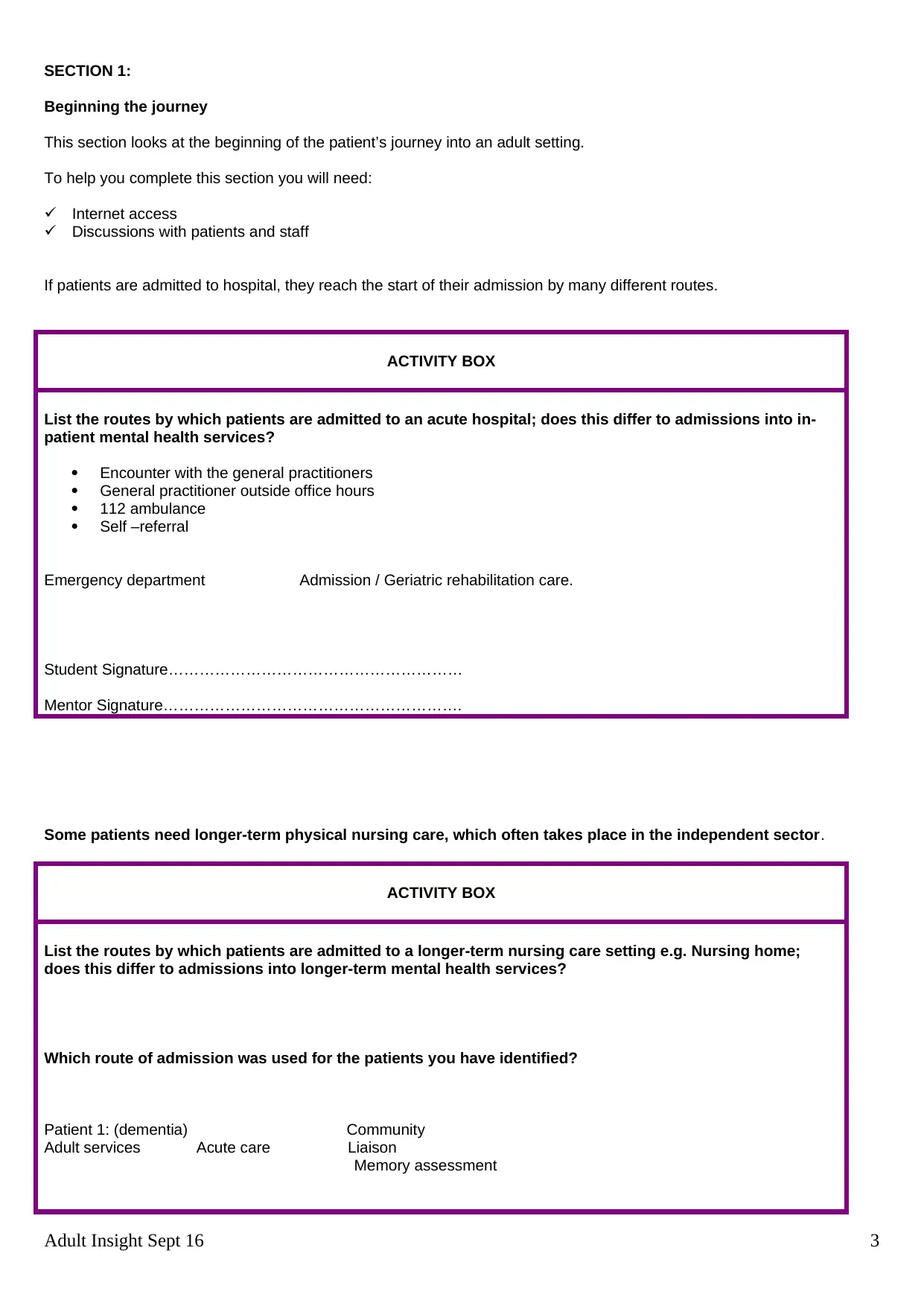
SECTION 1:
Beginning the journey
This section looks at the beginning of the patient’s journey into an adult setting.
To help you complete this section you will need:
Internet access
Discussions with patients and staff
If patients are admitted to hospital, they reach the start of their admission by many different routes.
ACTIVITY BOX
List the routes by which patients are admitted to an acute hospital; does this differ to admissions into in-
patient mental health services?
Encounter with the general practitioners
General practitioner outside office hours
112 ambulance
Self –referral
Emergency department Admission / Geriatric rehabilitation care.
Student Signature…………………………………………………
Mentor Signature………………………………………………….
Some patients need longer-term physical nursing care, which often takes place in the independent sector.
ACTIVITY BOX
List the routes by which patients are admitted to a longer-term nursing care setting e.g. Nursing home;
does this differ to admissions into longer-term mental health services?
Which route of admission was used for the patients you have identified?
Patient 1: (dementia) Community
Adult services Acute care Liaison
Memory assessment
Adult Insight Sept 16 3
Beginning the journey
This section looks at the beginning of the patient’s journey into an adult setting.
To help you complete this section you will need:
Internet access
Discussions with patients and staff
If patients are admitted to hospital, they reach the start of their admission by many different routes.
ACTIVITY BOX
List the routes by which patients are admitted to an acute hospital; does this differ to admissions into in-
patient mental health services?
Encounter with the general practitioners
General practitioner outside office hours
112 ambulance
Self –referral
Emergency department Admission / Geriatric rehabilitation care.
Student Signature…………………………………………………
Mentor Signature………………………………………………….
Some patients need longer-term physical nursing care, which often takes place in the independent sector.
ACTIVITY BOX
List the routes by which patients are admitted to a longer-term nursing care setting e.g. Nursing home;
does this differ to admissions into longer-term mental health services?
Which route of admission was used for the patients you have identified?
Patient 1: (dementia) Community
Adult services Acute care Liaison
Memory assessment
Adult Insight Sept 16 3
⊘ This is a preview!⊘
Do you want full access?
Subscribe today to unlock all pages.

Trusted by 1+ million students worldwide
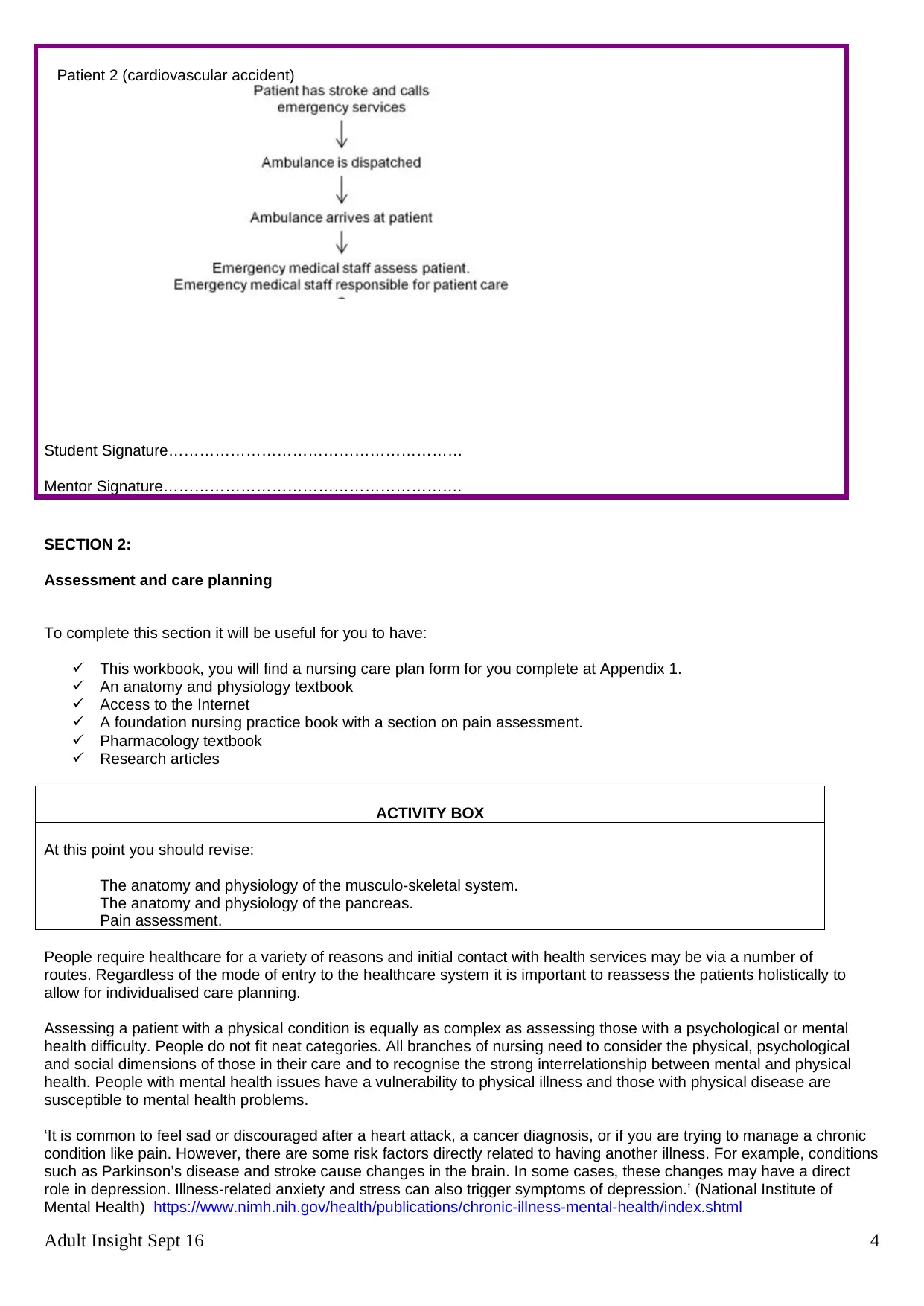
Patient 2 (cardiovascular accident)
Student Signature…………………………………………………
Mentor Signature………………………………………………….
SECTION 2:
Assessment and care planning
To complete this section it will be useful for you to have:
This workbook, you will find a nursing care plan form for you complete at Appendix 1.
An anatomy and physiology textbook
Access to the Internet
A foundation nursing practice book with a section on pain assessment.
Pharmacology textbook
Research articles
ACTIVITY BOX
At this point you should revise:
The anatomy and physiology of the musculo-skeletal system.
The anatomy and physiology of the pancreas.
Pain assessment.
People require healthcare for a variety of reasons and initial contact with health services may be via a number of
routes. Regardless of the mode of entry to the healthcare system it is important to reassess the patients holistically to
allow for individualised care planning.
Assessing a patient with a physical condition is equally as complex as assessing those with a psychological or mental
health difficulty. People do not fit neat categories. All branches of nursing need to consider the physical, psychological
and social dimensions of those in their care and to recognise the strong interrelationship between mental and physical
health. People with mental health issues have a vulnerability to physical illness and those with physical disease are
susceptible to mental health problems.
‘It is common to feel sad or discouraged after a heart attack, a cancer diagnosis, or if you are trying to manage a chronic
condition like pain. However, there are some risk factors directly related to having another illness. For example, conditions
such as Parkinson’s disease and stroke cause changes in the brain. In some cases, these changes may have a direct
role in depression. Illness-related anxiety and stress can also trigger symptoms of depression.’ (National Institute of
Mental Health) https://www.nimh.nih.gov/health/publications/chronic-illness-mental-health/index.shtml
Adult Insight Sept 16 4
Student Signature…………………………………………………
Mentor Signature………………………………………………….
SECTION 2:
Assessment and care planning
To complete this section it will be useful for you to have:
This workbook, you will find a nursing care plan form for you complete at Appendix 1.
An anatomy and physiology textbook
Access to the Internet
A foundation nursing practice book with a section on pain assessment.
Pharmacology textbook
Research articles
ACTIVITY BOX
At this point you should revise:
The anatomy and physiology of the musculo-skeletal system.
The anatomy and physiology of the pancreas.
Pain assessment.
People require healthcare for a variety of reasons and initial contact with health services may be via a number of
routes. Regardless of the mode of entry to the healthcare system it is important to reassess the patients holistically to
allow for individualised care planning.
Assessing a patient with a physical condition is equally as complex as assessing those with a psychological or mental
health difficulty. People do not fit neat categories. All branches of nursing need to consider the physical, psychological
and social dimensions of those in their care and to recognise the strong interrelationship between mental and physical
health. People with mental health issues have a vulnerability to physical illness and those with physical disease are
susceptible to mental health problems.
‘It is common to feel sad or discouraged after a heart attack, a cancer diagnosis, or if you are trying to manage a chronic
condition like pain. However, there are some risk factors directly related to having another illness. For example, conditions
such as Parkinson’s disease and stroke cause changes in the brain. In some cases, these changes may have a direct
role in depression. Illness-related anxiety and stress can also trigger symptoms of depression.’ (National Institute of
Mental Health) https://www.nimh.nih.gov/health/publications/chronic-illness-mental-health/index.shtml
Adult Insight Sept 16 4
Paraphrase This Document
Need a fresh take? Get an instant paraphrase of this document with our AI Paraphraser
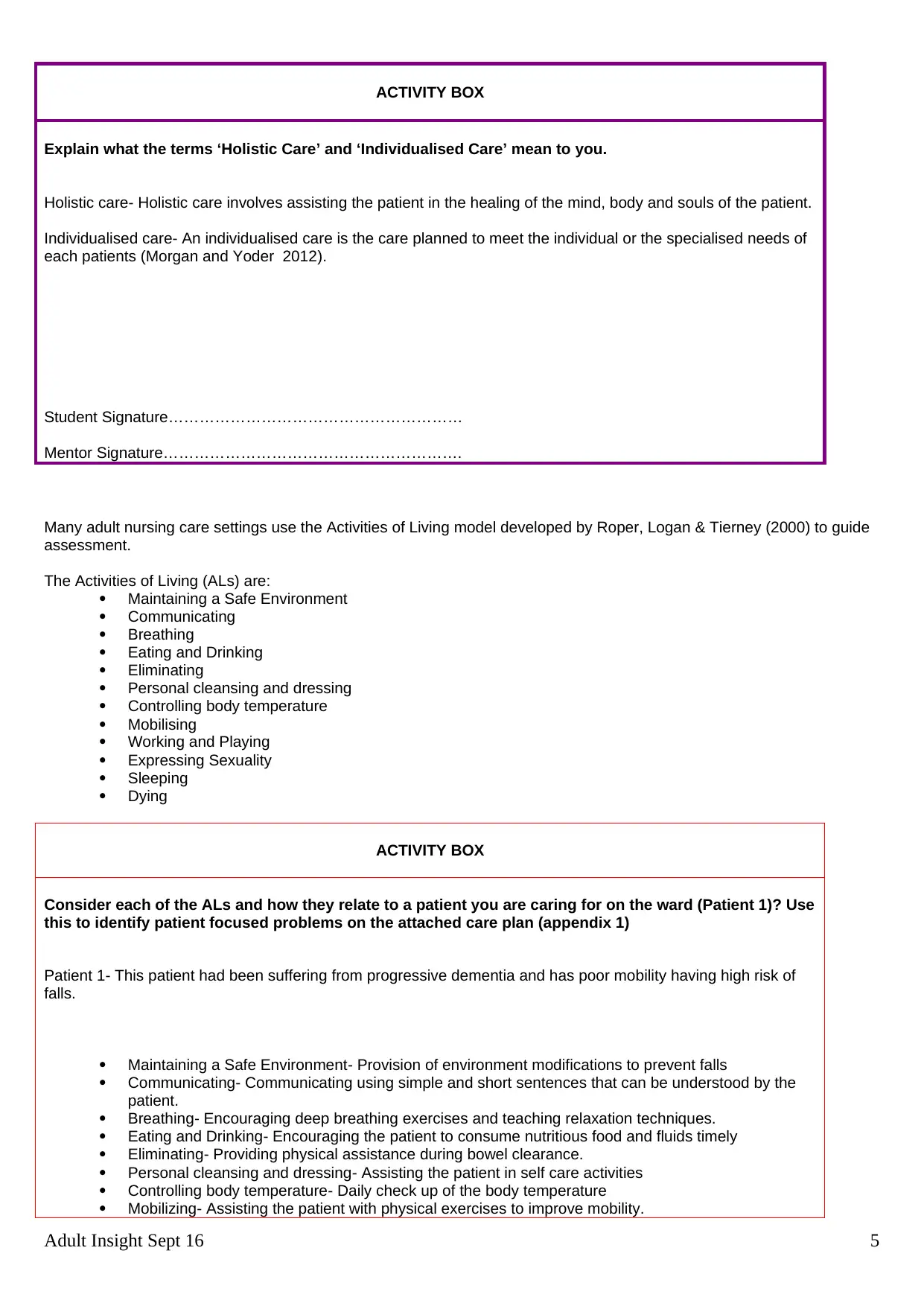
ACTIVITY BOX
Explain what the terms ‘Holistic Care’ and ‘Individualised Care’ mean to you.
Holistic care- Holistic care involves assisting the patient in the healing of the mind, body and souls of the patient.
Individualised care- An individualised care is the care planned to meet the individual or the specialised needs of
each patients (Morgan and Yoder 2012).
Student Signature…………………………………………………
Mentor Signature………………………………………………….
Many adult nursing care settings use the Activities of Living model developed by Roper, Logan & Tierney (2000) to guide
assessment.
The Activities of Living (ALs) are:
Maintaining a Safe Environment
Communicating
Breathing
Eating and Drinking
Eliminating
Personal cleansing and dressing
Controlling body temperature
Mobilising
Working and Playing
Expressing Sexuality
Sleeping
Dying
ACTIVITY BOX
Consider each of the ALs and how they relate to a patient you are caring for on the ward (Patient 1)? Use
this to identify patient focused problems on the attached care plan (appendix 1)
Patient 1- This patient had been suffering from progressive dementia and has poor mobility having high risk of
falls.
Maintaining a Safe Environment- Provision of environment modifications to prevent falls
Communicating- Communicating using simple and short sentences that can be understood by the
patient.
Breathing- Encouraging deep breathing exercises and teaching relaxation techniques.
Eating and Drinking- Encouraging the patient to consume nutritious food and fluids timely
Eliminating- Providing physical assistance during bowel clearance.
Personal cleansing and dressing- Assisting the patient in self care activities
Controlling body temperature- Daily check up of the body temperature
Mobilizing- Assisting the patient with physical exercises to improve mobility.
Adult Insight Sept 16 5
Explain what the terms ‘Holistic Care’ and ‘Individualised Care’ mean to you.
Holistic care- Holistic care involves assisting the patient in the healing of the mind, body and souls of the patient.
Individualised care- An individualised care is the care planned to meet the individual or the specialised needs of
each patients (Morgan and Yoder 2012).
Student Signature…………………………………………………
Mentor Signature………………………………………………….
Many adult nursing care settings use the Activities of Living model developed by Roper, Logan & Tierney (2000) to guide
assessment.
The Activities of Living (ALs) are:
Maintaining a Safe Environment
Communicating
Breathing
Eating and Drinking
Eliminating
Personal cleansing and dressing
Controlling body temperature
Mobilising
Working and Playing
Expressing Sexuality
Sleeping
Dying
ACTIVITY BOX
Consider each of the ALs and how they relate to a patient you are caring for on the ward (Patient 1)? Use
this to identify patient focused problems on the attached care plan (appendix 1)
Patient 1- This patient had been suffering from progressive dementia and has poor mobility having high risk of
falls.
Maintaining a Safe Environment- Provision of environment modifications to prevent falls
Communicating- Communicating using simple and short sentences that can be understood by the
patient.
Breathing- Encouraging deep breathing exercises and teaching relaxation techniques.
Eating and Drinking- Encouraging the patient to consume nutritious food and fluids timely
Eliminating- Providing physical assistance during bowel clearance.
Personal cleansing and dressing- Assisting the patient in self care activities
Controlling body temperature- Daily check up of the body temperature
Mobilizing- Assisting the patient with physical exercises to improve mobility.
Adult Insight Sept 16 5
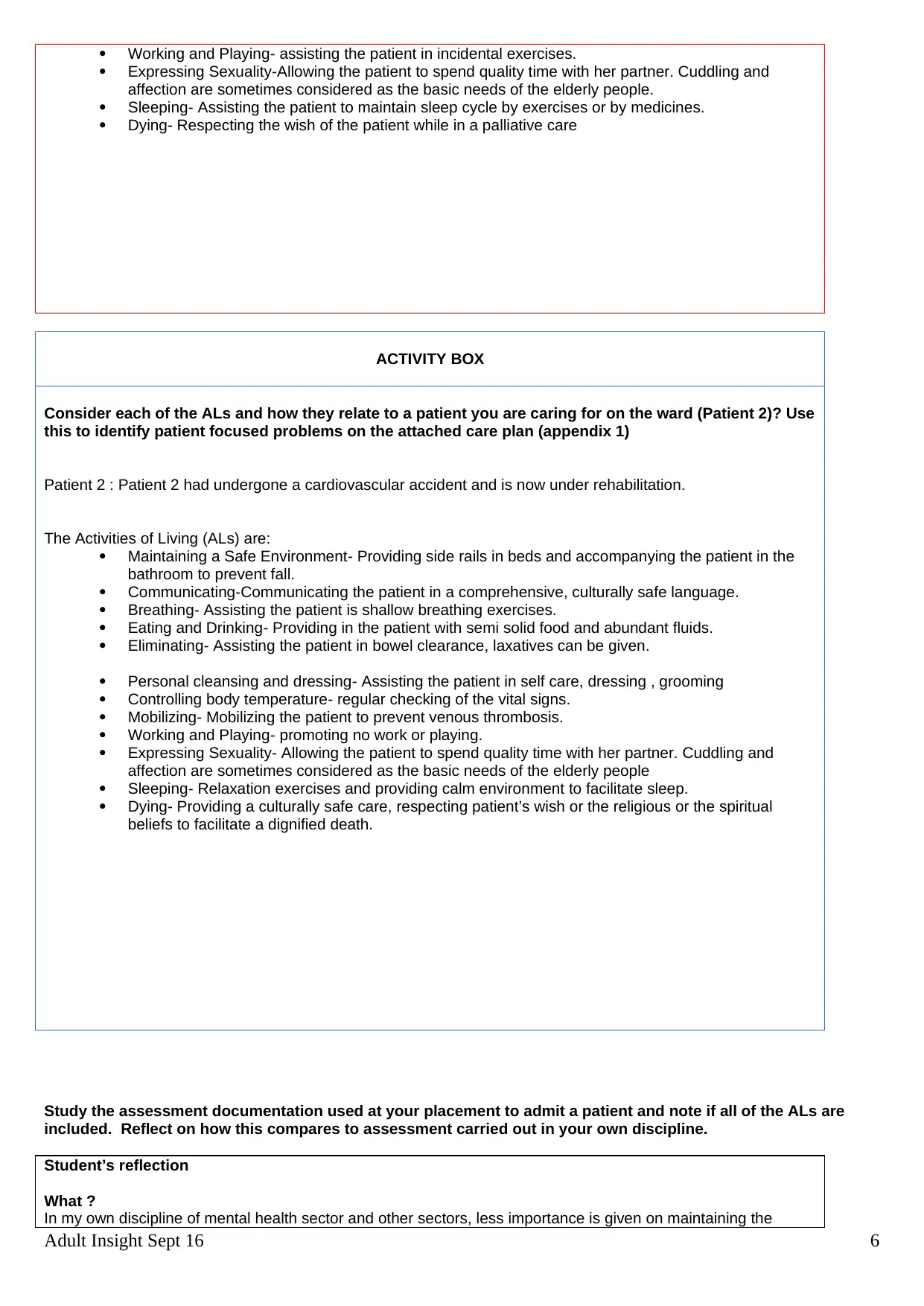
Working and Playing- assisting the patient in incidental exercises.
Expressing Sexuality-Allowing the patient to spend quality time with her partner. Cuddling and
affection are sometimes considered as the basic needs of the elderly people.
Sleeping- Assisting the patient to maintain sleep cycle by exercises or by medicines.
Dying- Respecting the wish of the patient while in a palliative care
ACTIVITY BOX
Consider each of the ALs and how they relate to a patient you are caring for on the ward (Patient 2)? Use
this to identify patient focused problems on the attached care plan (appendix 1)
Patient 2 : Patient 2 had undergone a cardiovascular accident and is now under rehabilitation.
The Activities of Living (ALs) are:
Maintaining a Safe Environment- Providing side rails in beds and accompanying the patient in the
bathroom to prevent fall.
Communicating-Communicating the patient in a comprehensive, culturally safe language.
Breathing- Assisting the patient is shallow breathing exercises.
Eating and Drinking- Providing in the patient with semi solid food and abundant fluids.
Eliminating- Assisting the patient in bowel clearance, laxatives can be given.
Personal cleansing and dressing- Assisting the patient in self care, dressing , grooming
Controlling body temperature- regular checking of the vital signs.
Mobilizing- Mobilizing the patient to prevent venous thrombosis.
Working and Playing- promoting no work or playing.
Expressing Sexuality- Allowing the patient to spend quality time with her partner. Cuddling and
affection are sometimes considered as the basic needs of the elderly people
Sleeping- Relaxation exercises and providing calm environment to facilitate sleep.
Dying- Providing a culturally safe care, respecting patient’s wish or the religious or the spiritual
beliefs to facilitate a dignified death.
Study the assessment documentation used at your placement to admit a patient and note if all of the ALs are
included. Reflect on how this compares to assessment carried out in your own discipline.
Student’s reflection
What ?
In my own discipline of mental health sector and other sectors, less importance is given on maintaining the
Adult Insight Sept 16 6
Expressing Sexuality-Allowing the patient to spend quality time with her partner. Cuddling and
affection are sometimes considered as the basic needs of the elderly people.
Sleeping- Assisting the patient to maintain sleep cycle by exercises or by medicines.
Dying- Respecting the wish of the patient while in a palliative care
ACTIVITY BOX
Consider each of the ALs and how they relate to a patient you are caring for on the ward (Patient 2)? Use
this to identify patient focused problems on the attached care plan (appendix 1)
Patient 2 : Patient 2 had undergone a cardiovascular accident and is now under rehabilitation.
The Activities of Living (ALs) are:
Maintaining a Safe Environment- Providing side rails in beds and accompanying the patient in the
bathroom to prevent fall.
Communicating-Communicating the patient in a comprehensive, culturally safe language.
Breathing- Assisting the patient is shallow breathing exercises.
Eating and Drinking- Providing in the patient with semi solid food and abundant fluids.
Eliminating- Assisting the patient in bowel clearance, laxatives can be given.
Personal cleansing and dressing- Assisting the patient in self care, dressing , grooming
Controlling body temperature- regular checking of the vital signs.
Mobilizing- Mobilizing the patient to prevent venous thrombosis.
Working and Playing- promoting no work or playing.
Expressing Sexuality- Allowing the patient to spend quality time with her partner. Cuddling and
affection are sometimes considered as the basic needs of the elderly people
Sleeping- Relaxation exercises and providing calm environment to facilitate sleep.
Dying- Providing a culturally safe care, respecting patient’s wish or the religious or the spiritual
beliefs to facilitate a dignified death.
Study the assessment documentation used at your placement to admit a patient and note if all of the ALs are
included. Reflect on how this compares to assessment carried out in your own discipline.
Student’s reflection
What ?
In my own discipline of mental health sector and other sectors, less importance is given on maintaining the
Adult Insight Sept 16 6
⊘ This is a preview!⊘
Do you want full access?
Subscribe today to unlock all pages.

Trusted by 1+ million students worldwide
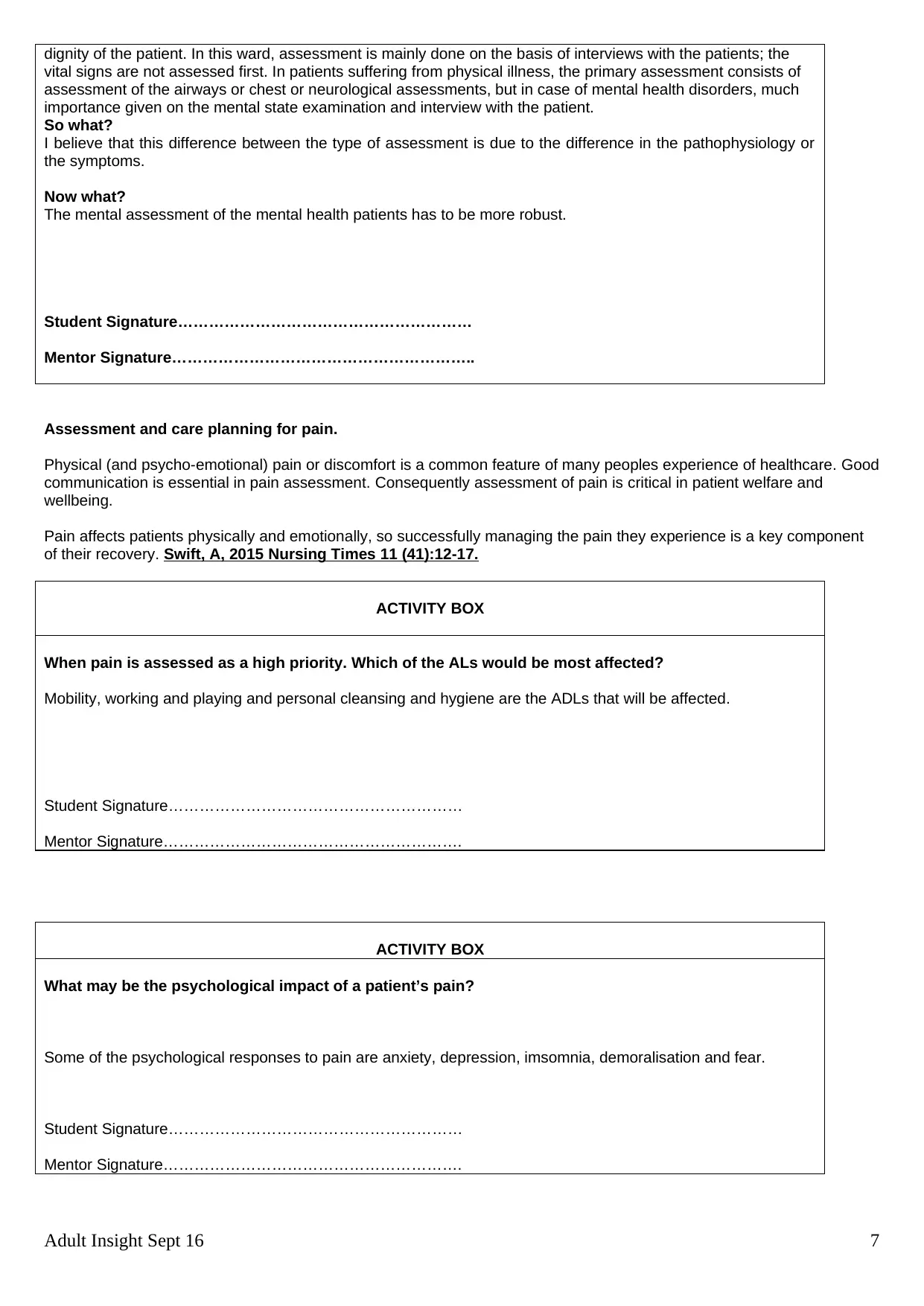
dignity of the patient. In this ward, assessment is mainly done on the basis of interviews with the patients; the
vital signs are not assessed first. In patients suffering from physical illness, the primary assessment consists of
assessment of the airways or chest or neurological assessments, but in case of mental health disorders, much
importance given on the mental state examination and interview with the patient.
So what?
I believe that this difference between the type of assessment is due to the difference in the pathophysiology or
the symptoms.
Now what?
The mental assessment of the mental health patients has to be more robust.
Student Signature…………………………………………………
Mentor Signature…………………………………………………..
Assessment and care planning for pain.
Physical (and psycho-emotional) pain or discomfort is a common feature of many peoples experience of healthcare. Good
communication is essential in pain assessment. Consequently assessment of pain is critical in patient welfare and
wellbeing.
Pain affects patients physically and emotionally, so successfully managing the pain they experience is a key component
of their recovery. Swift, A, 2015 Nursing Times 11 (41):12-17.
ACTIVITY BOX
When pain is assessed as a high priority. Which of the ALs would be most affected?
Mobility, working and playing and personal cleansing and hygiene are the ADLs that will be affected.
Student Signature…………………………………………………
Mentor Signature………………………………………………….
ACTIVITY BOX
What may be the psychological impact of a patient’s pain?
Some of the psychological responses to pain are anxiety, depression, imsomnia, demoralisation and fear.
Student Signature…………………………………………………
Mentor Signature………………………………………………….
Adult Insight Sept 16 7
vital signs are not assessed first. In patients suffering from physical illness, the primary assessment consists of
assessment of the airways or chest or neurological assessments, but in case of mental health disorders, much
importance given on the mental state examination and interview with the patient.
So what?
I believe that this difference between the type of assessment is due to the difference in the pathophysiology or
the symptoms.
Now what?
The mental assessment of the mental health patients has to be more robust.
Student Signature…………………………………………………
Mentor Signature…………………………………………………..
Assessment and care planning for pain.
Physical (and psycho-emotional) pain or discomfort is a common feature of many peoples experience of healthcare. Good
communication is essential in pain assessment. Consequently assessment of pain is critical in patient welfare and
wellbeing.
Pain affects patients physically and emotionally, so successfully managing the pain they experience is a key component
of their recovery. Swift, A, 2015 Nursing Times 11 (41):12-17.
ACTIVITY BOX
When pain is assessed as a high priority. Which of the ALs would be most affected?
Mobility, working and playing and personal cleansing and hygiene are the ADLs that will be affected.
Student Signature…………………………………………………
Mentor Signature………………………………………………….
ACTIVITY BOX
What may be the psychological impact of a patient’s pain?
Some of the psychological responses to pain are anxiety, depression, imsomnia, demoralisation and fear.
Student Signature…………………………………………………
Mentor Signature………………………………………………….
Adult Insight Sept 16 7
Paraphrase This Document
Need a fresh take? Get an instant paraphrase of this document with our AI Paraphraser
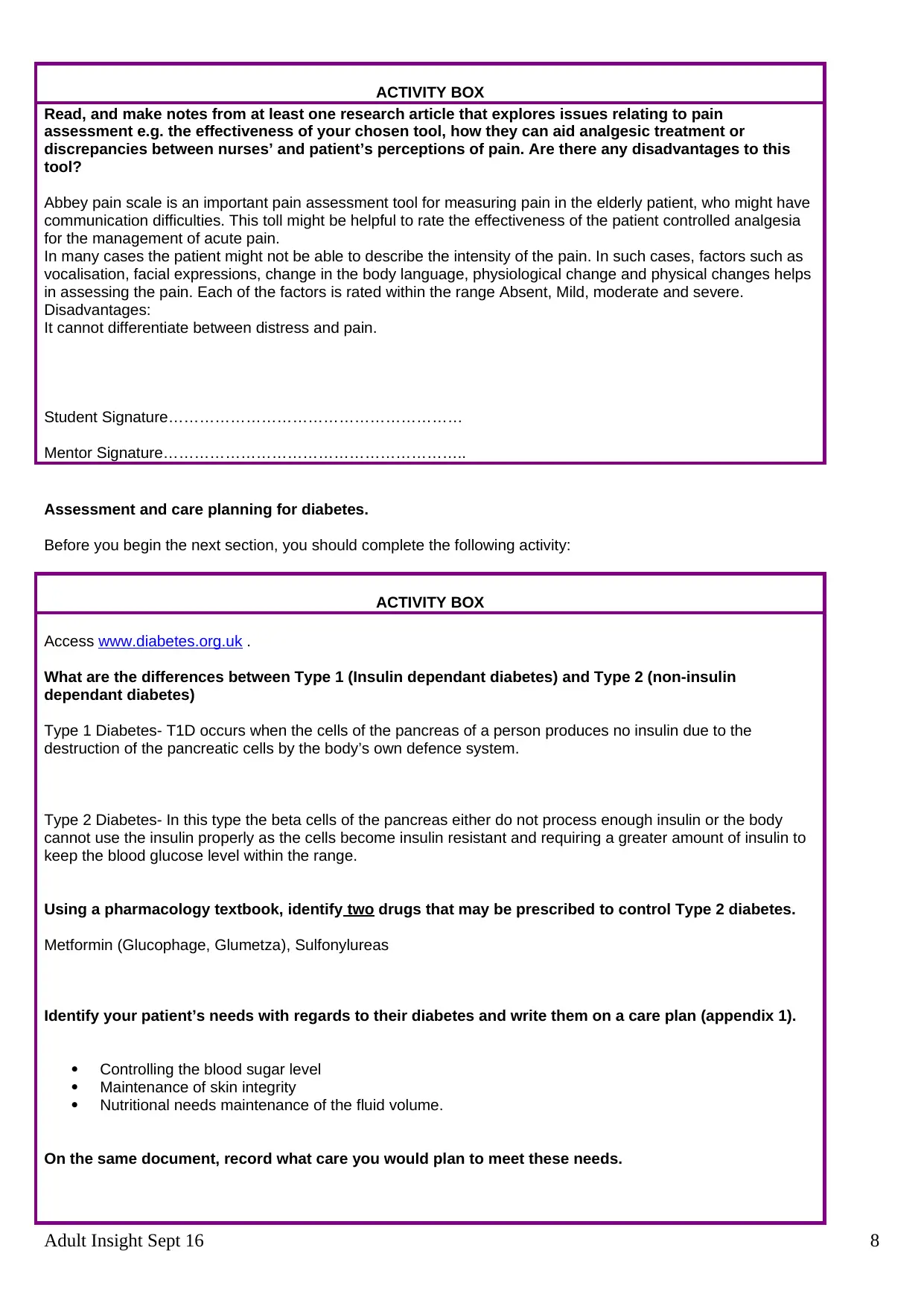
ACTIVITY BOX
Read, and make notes from at least one research article that explores issues relating to pain
assessment e.g. the effectiveness of your chosen tool, how they can aid analgesic treatment or
discrepancies between nurses’ and patient’s perceptions of pain. Are there any disadvantages to this
tool?
Abbey pain scale is an important pain assessment tool for measuring pain in the elderly patient, who might have
communication difficulties. This toll might be helpful to rate the effectiveness of the patient controlled analgesia
for the management of acute pain.
In many cases the patient might not be able to describe the intensity of the pain. In such cases, factors such as
vocalisation, facial expressions, change in the body language, physiological change and physical changes helps
in assessing the pain. Each of the factors is rated within the range Absent, Mild, moderate and severe.
Disadvantages:
It cannot differentiate between distress and pain.
Student Signature…………………………………………………
Mentor Signature…………………………………………………..
Assessment and care planning for diabetes.
Before you begin the next section, you should complete the following activity:
ACTIVITY BOX
Access www.diabetes.org.uk .
What are the differences between Type 1 (Insulin dependant diabetes) and Type 2 (non-insulin
dependant diabetes)
Type 1 Diabetes- T1D occurs when the cells of the pancreas of a person produces no insulin due to the
destruction of the pancreatic cells by the body’s own defence system.
Type 2 Diabetes- In this type the beta cells of the pancreas either do not process enough insulin or the body
cannot use the insulin properly as the cells become insulin resistant and requiring a greater amount of insulin to
keep the blood glucose level within the range.
Using a pharmacology textbook, identify two drugs that may be prescribed to control Type 2 diabetes.
Metformin (Glucophage, Glumetza), Sulfonylureas
Identify your patient’s needs with regards to their diabetes and write them on a care plan (appendix 1).
Controlling the blood sugar level
Maintenance of skin integrity
Nutritional needs maintenance of the fluid volume.
On the same document, record what care you would plan to meet these needs.
Adult Insight Sept 16 8
Read, and make notes from at least one research article that explores issues relating to pain
assessment e.g. the effectiveness of your chosen tool, how they can aid analgesic treatment or
discrepancies between nurses’ and patient’s perceptions of pain. Are there any disadvantages to this
tool?
Abbey pain scale is an important pain assessment tool for measuring pain in the elderly patient, who might have
communication difficulties. This toll might be helpful to rate the effectiveness of the patient controlled analgesia
for the management of acute pain.
In many cases the patient might not be able to describe the intensity of the pain. In such cases, factors such as
vocalisation, facial expressions, change in the body language, physiological change and physical changes helps
in assessing the pain. Each of the factors is rated within the range Absent, Mild, moderate and severe.
Disadvantages:
It cannot differentiate between distress and pain.
Student Signature…………………………………………………
Mentor Signature…………………………………………………..
Assessment and care planning for diabetes.
Before you begin the next section, you should complete the following activity:
ACTIVITY BOX
Access www.diabetes.org.uk .
What are the differences between Type 1 (Insulin dependant diabetes) and Type 2 (non-insulin
dependant diabetes)
Type 1 Diabetes- T1D occurs when the cells of the pancreas of a person produces no insulin due to the
destruction of the pancreatic cells by the body’s own defence system.
Type 2 Diabetes- In this type the beta cells of the pancreas either do not process enough insulin or the body
cannot use the insulin properly as the cells become insulin resistant and requiring a greater amount of insulin to
keep the blood glucose level within the range.
Using a pharmacology textbook, identify two drugs that may be prescribed to control Type 2 diabetes.
Metformin (Glucophage, Glumetza), Sulfonylureas
Identify your patient’s needs with regards to their diabetes and write them on a care plan (appendix 1).
Controlling the blood sugar level
Maintenance of skin integrity
Nutritional needs maintenance of the fluid volume.
On the same document, record what care you would plan to meet these needs.
Adult Insight Sept 16 8
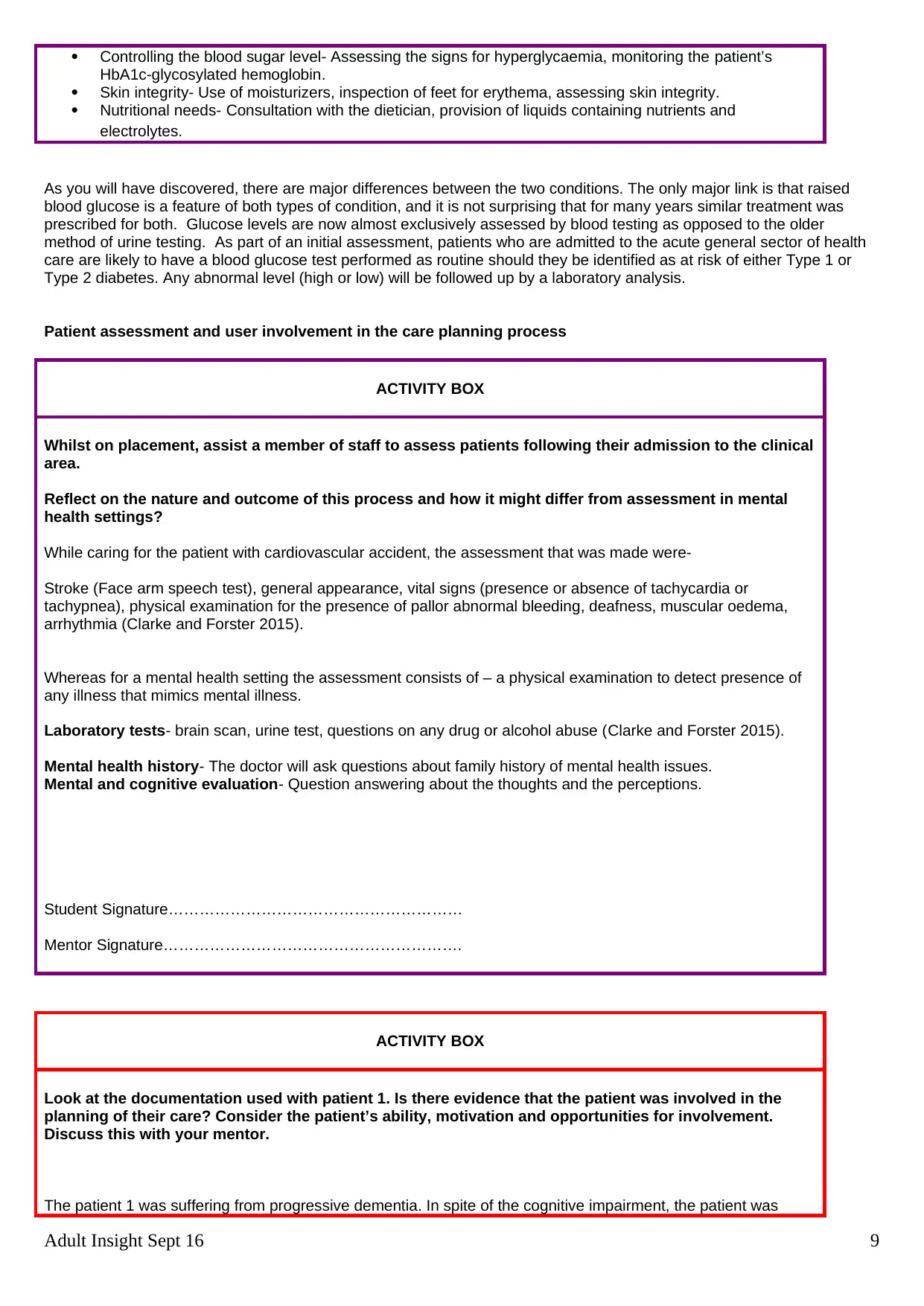
Controlling the blood sugar level- Assessing the signs for hyperglycaemia, monitoring the patient’s
HbA1c-glycosylated hemoglobin.
Skin integrity- Use of moisturizers, inspection of feet for erythema, assessing skin integrity.
Nutritional needs- Consultation with the dietician, provision of liquids containing nutrients and
electrolytes.
As you will have discovered, there are major differences between the two conditions. The only major link is that raised
blood glucose is a feature of both types of condition, and it is not surprising that for many years similar treatment was
prescribed for both. Glucose levels are now almost exclusively assessed by blood testing as opposed to the older
method of urine testing. As part of an initial assessment, patients who are admitted to the acute general sector of health
care are likely to have a blood glucose test performed as routine should they be identified as at risk of either Type 1 or
Type 2 diabetes. Any abnormal level (high or low) will be followed up by a laboratory analysis.
Patient assessment and user involvement in the care planning process
ACTIVITY BOX
Whilst on placement, assist a member of staff to assess patients following their admission to the clinical
area.
Reflect on the nature and outcome of this process and how it might differ from assessment in mental
health settings?
While caring for the patient with cardiovascular accident, the assessment that was made were-
Stroke (Face arm speech test), general appearance, vital signs (presence or absence of tachycardia or
tachypnea), physical examination for the presence of pallor abnormal bleeding, deafness, muscular oedema,
arrhythmia (Clarke and Forster 2015).
Whereas for a mental health setting the assessment consists of – a physical examination to detect presence of
any illness that mimics mental illness.
Laboratory tests- brain scan, urine test, questions on any drug or alcohol abuse (Clarke and Forster 2015).
Mental health history- The doctor will ask questions about family history of mental health issues.
Mental and cognitive evaluation- Question answering about the thoughts and the perceptions.
Student Signature…………………………………………………
Mentor Signature………………………………………………….
ACTIVITY BOX
Look at the documentation used with patient 1. Is there evidence that the patient was involved in the
planning of their care? Consider the patient’s ability, motivation and opportunities for involvement.
Discuss this with your mentor.
The patient 1 was suffering from progressive dementia. In spite of the cognitive impairment, the patient was
Adult Insight Sept 16 9
HbA1c-glycosylated hemoglobin.
Skin integrity- Use of moisturizers, inspection of feet for erythema, assessing skin integrity.
Nutritional needs- Consultation with the dietician, provision of liquids containing nutrients and
electrolytes.
As you will have discovered, there are major differences between the two conditions. The only major link is that raised
blood glucose is a feature of both types of condition, and it is not surprising that for many years similar treatment was
prescribed for both. Glucose levels are now almost exclusively assessed by blood testing as opposed to the older
method of urine testing. As part of an initial assessment, patients who are admitted to the acute general sector of health
care are likely to have a blood glucose test performed as routine should they be identified as at risk of either Type 1 or
Type 2 diabetes. Any abnormal level (high or low) will be followed up by a laboratory analysis.
Patient assessment and user involvement in the care planning process
ACTIVITY BOX
Whilst on placement, assist a member of staff to assess patients following their admission to the clinical
area.
Reflect on the nature and outcome of this process and how it might differ from assessment in mental
health settings?
While caring for the patient with cardiovascular accident, the assessment that was made were-
Stroke (Face arm speech test), general appearance, vital signs (presence or absence of tachycardia or
tachypnea), physical examination for the presence of pallor abnormal bleeding, deafness, muscular oedema,
arrhythmia (Clarke and Forster 2015).
Whereas for a mental health setting the assessment consists of – a physical examination to detect presence of
any illness that mimics mental illness.
Laboratory tests- brain scan, urine test, questions on any drug or alcohol abuse (Clarke and Forster 2015).
Mental health history- The doctor will ask questions about family history of mental health issues.
Mental and cognitive evaluation- Question answering about the thoughts and the perceptions.
Student Signature…………………………………………………
Mentor Signature………………………………………………….
ACTIVITY BOX
Look at the documentation used with patient 1. Is there evidence that the patient was involved in the
planning of their care? Consider the patient’s ability, motivation and opportunities for involvement.
Discuss this with your mentor.
The patient 1 was suffering from progressive dementia. In spite of the cognitive impairment, the patient was
Adult Insight Sept 16 9
⊘ This is a preview!⊘
Do you want full access?
Subscribe today to unlock all pages.

Trusted by 1+ million students worldwide

involved in the planning of care. Such as patient was asked each time whether he needed any assistance in
toileting activities and dressing. Autonomy was given to the patient in terms of self care activities. The patient
was discussed with the entire treatment regimen in front a trusted member of the family and consent was taken
from patient before carrying out the treatment.
Student Signature…………………………………………………
Mentor Signature………………………………………………….
ACTIVITY BOX
Look at the documentation used with patient 2. Is there evidence that the patient was involved in the
planning of their care? Consider the patient’s ability, motivation and opportunities for involvement.
Discuss this with your mentor.
The patient 2 had suffered from a cardiovascular accident.
The patient was involved while chalking out the rehabilitation procedure. The patient was given the opportunity
to choose the type of rehabilitation, any nutritional preferences while making the diet plan. The patient was
encouraged to do mild exercises on her own. Furthermore, patient consent was considered before carrying out
any procedures.
Student Signature…………………………………………………
Mentor Signature………………………………………………….
ACTIVITY BOX
Whilst on placement note the type of specimens that are collected, the procedures for collecting those
specimens, the required documentation and how results are recorded. Make some notes below.
Blood, sputum, urine and stool specimens are often collected by the nurses for testing. Specimen should be
collected at the best time possible. Appropriate collection devices like sterile, leak proof specimen containers
should be used. All the containers should be labelled and the test request form has to be filled. Nurses are also
Adult Insight Sept 16 10
toileting activities and dressing. Autonomy was given to the patient in terms of self care activities. The patient
was discussed with the entire treatment regimen in front a trusted member of the family and consent was taken
from patient before carrying out the treatment.
Student Signature…………………………………………………
Mentor Signature………………………………………………….
ACTIVITY BOX
Look at the documentation used with patient 2. Is there evidence that the patient was involved in the
planning of their care? Consider the patient’s ability, motivation and opportunities for involvement.
Discuss this with your mentor.
The patient 2 had suffered from a cardiovascular accident.
The patient was involved while chalking out the rehabilitation procedure. The patient was given the opportunity
to choose the type of rehabilitation, any nutritional preferences while making the diet plan. The patient was
encouraged to do mild exercises on her own. Furthermore, patient consent was considered before carrying out
any procedures.
Student Signature…………………………………………………
Mentor Signature………………………………………………….
ACTIVITY BOX
Whilst on placement note the type of specimens that are collected, the procedures for collecting those
specimens, the required documentation and how results are recorded. Make some notes below.
Blood, sputum, urine and stool specimens are often collected by the nurses for testing. Specimen should be
collected at the best time possible. Appropriate collection devices like sterile, leak proof specimen containers
should be used. All the containers should be labelled and the test request form has to be filled. Nurses are also
Adult Insight Sept 16 10
Paraphrase This Document
Need a fresh take? Get an instant paraphrase of this document with our AI Paraphraser

responsible for the timely transfer of the samples. The results are sent electronically from the pathology lab and
the nurse transfers it over to the specialist.
Student Signature…………………………………………………
Mentor Signature………………………………………………….
Factfile
Patients with diabetes are at higher risk of mental health disorders — including depression and psychotic disorders — than
the general population (2015) http://www.thelancet.com/diabetes-and-mental-health-disorders
“For both first and second generation antipsychotics the incidence of diabetes increased with the number of prescriptions.
Additionally, the incidence of diabetes increased with the number of combined antipsychotic drugs. (Kessing, Thimson,
Mogensen & Anderson, 2010)
Research has shown that diabetes can increase the risk of developing both Alzheimer's disease and vascular dementia.
https://www.alzheimers.org.uk/info/20053/research_projects/753/investigating_the_relationship_between_diabetes_and_dementia
SECTION 3: Implementation and Evaluation of care
To help you complete this section it will be useful to have:
A pharmacology textbook
Access to the Internet
NMC The Code
The next stage of the nursing process requires that the problems identified at assessment and the associated care
planned is implemented. As you have seen these problems, particularly the pain, affect the Activities of Living and so to
restore equilibrium the problems prioritised must be treated.
ACTIVITY BOX
Using the pharmacology text book, identify one drug that is used for severe pain.
What are the actions and interactions of this drug?
How long is its duration of action?
What are its possible side effects?
Opioids (Morphine)
Actions and interactions
Morphine acts by acting on the receptors located in the neuronal cell membrane. It inhibits the release of the
neurotransmitters thus inhibiting pain.
Morphine may interact with the drugs such as opioid agonist like pentazocine, naltrexone.
Duration of action
Effects of Morphine taken orally stays for 4-5 hours
Effect of subcutaneously applied morphine takes place for 4-5 hours.
Adult Insight Sept 16 11
the nurse transfers it over to the specialist.
Student Signature…………………………………………………
Mentor Signature………………………………………………….
Factfile
Patients with diabetes are at higher risk of mental health disorders — including depression and psychotic disorders — than
the general population (2015) http://www.thelancet.com/diabetes-and-mental-health-disorders
“For both first and second generation antipsychotics the incidence of diabetes increased with the number of prescriptions.
Additionally, the incidence of diabetes increased with the number of combined antipsychotic drugs. (Kessing, Thimson,
Mogensen & Anderson, 2010)
Research has shown that diabetes can increase the risk of developing both Alzheimer's disease and vascular dementia.
https://www.alzheimers.org.uk/info/20053/research_projects/753/investigating_the_relationship_between_diabetes_and_dementia
SECTION 3: Implementation and Evaluation of care
To help you complete this section it will be useful to have:
A pharmacology textbook
Access to the Internet
NMC The Code
The next stage of the nursing process requires that the problems identified at assessment and the associated care
planned is implemented. As you have seen these problems, particularly the pain, affect the Activities of Living and so to
restore equilibrium the problems prioritised must be treated.
ACTIVITY BOX
Using the pharmacology text book, identify one drug that is used for severe pain.
What are the actions and interactions of this drug?
How long is its duration of action?
What are its possible side effects?
Opioids (Morphine)
Actions and interactions
Morphine acts by acting on the receptors located in the neuronal cell membrane. It inhibits the release of the
neurotransmitters thus inhibiting pain.
Morphine may interact with the drugs such as opioid agonist like pentazocine, naltrexone.
Duration of action
Effects of Morphine taken orally stays for 4-5 hours
Effect of subcutaneously applied morphine takes place for 4-5 hours.
Adult Insight Sept 16 11
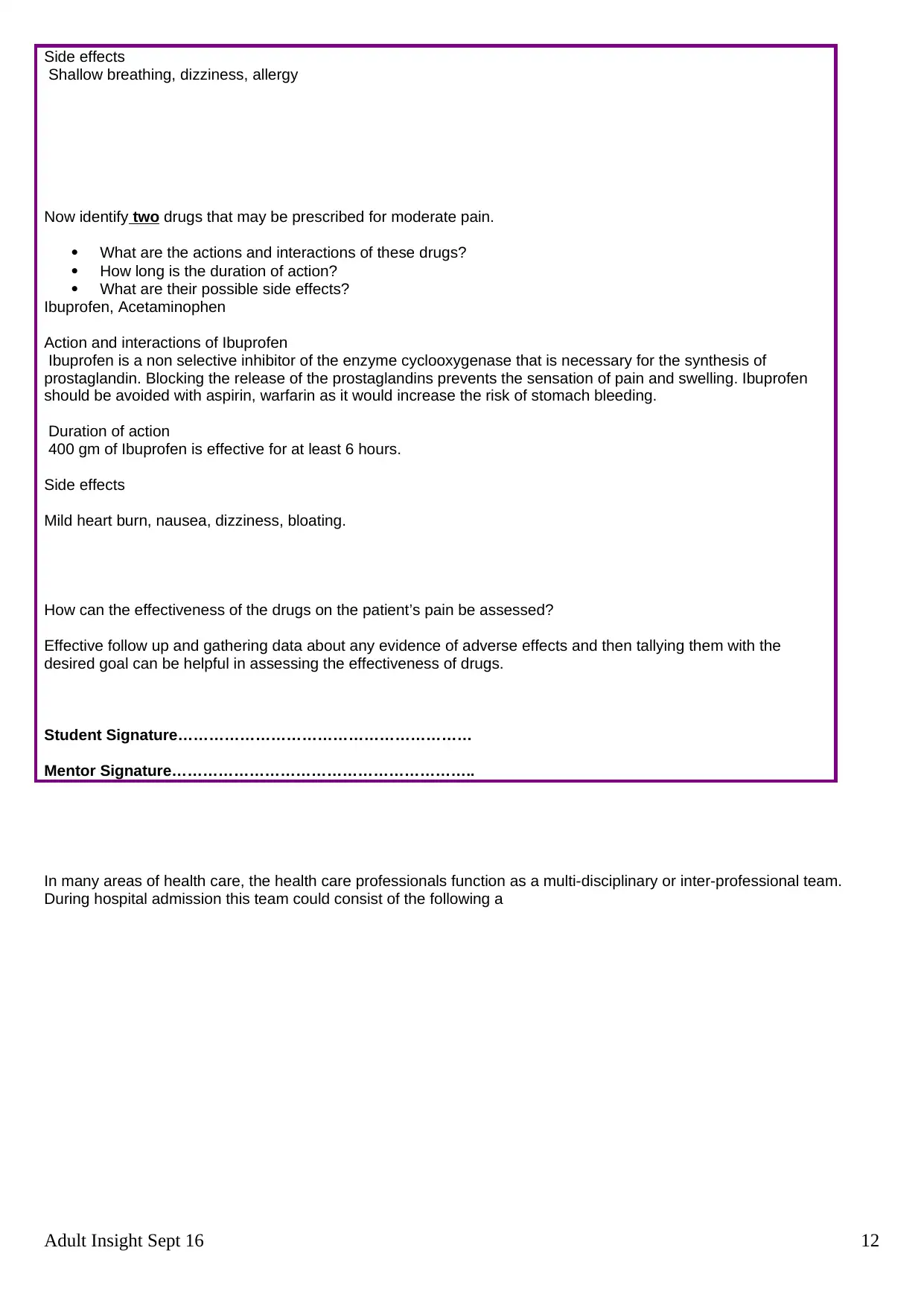
Side effects
Shallow breathing, dizziness, allergy
Now identify two drugs that may be prescribed for moderate pain.
What are the actions and interactions of these drugs?
How long is the duration of action?
What are their possible side effects?
Ibuprofen, Acetaminophen
Action and interactions of Ibuprofen
Ibuprofen is a non selective inhibitor of the enzyme cyclooxygenase that is necessary for the synthesis of
prostaglandin. Blocking the release of the prostaglandins prevents the sensation of pain and swelling. Ibuprofen
should be avoided with aspirin, warfarin as it would increase the risk of stomach bleeding.
Duration of action
400 gm of Ibuprofen is effective for at least 6 hours.
Side effects
Mild heart burn, nausea, dizziness, bloating.
How can the effectiveness of the drugs on the patient’s pain be assessed?
Effective follow up and gathering data about any evidence of adverse effects and then tallying them with the
desired goal can be helpful in assessing the effectiveness of drugs.
Student Signature…………………………………………………
Mentor Signature…………………………………………………..
In many areas of health care, the health care professionals function as a multi-disciplinary or inter-professional team.
During hospital admission this team could consist of the following a
Adult Insight Sept 16 12
Shallow breathing, dizziness, allergy
Now identify two drugs that may be prescribed for moderate pain.
What are the actions and interactions of these drugs?
How long is the duration of action?
What are their possible side effects?
Ibuprofen, Acetaminophen
Action and interactions of Ibuprofen
Ibuprofen is a non selective inhibitor of the enzyme cyclooxygenase that is necessary for the synthesis of
prostaglandin. Blocking the release of the prostaglandins prevents the sensation of pain and swelling. Ibuprofen
should be avoided with aspirin, warfarin as it would increase the risk of stomach bleeding.
Duration of action
400 gm of Ibuprofen is effective for at least 6 hours.
Side effects
Mild heart burn, nausea, dizziness, bloating.
How can the effectiveness of the drugs on the patient’s pain be assessed?
Effective follow up and gathering data about any evidence of adverse effects and then tallying them with the
desired goal can be helpful in assessing the effectiveness of drugs.
Student Signature…………………………………………………
Mentor Signature…………………………………………………..
In many areas of health care, the health care professionals function as a multi-disciplinary or inter-professional team.
During hospital admission this team could consist of the following a
Adult Insight Sept 16 12
⊘ This is a preview!⊘
Do you want full access?
Subscribe today to unlock all pages.

Trusted by 1+ million students worldwide
1 out of 28
Related Documents
Your All-in-One AI-Powered Toolkit for Academic Success.
+13062052269
info@desklib.com
Available 24*7 on WhatsApp / Email
![[object Object]](/_next/static/media/star-bottom.7253800d.svg)
Unlock your academic potential
Copyright © 2020–2026 A2Z Services. All Rights Reserved. Developed and managed by ZUCOL.





